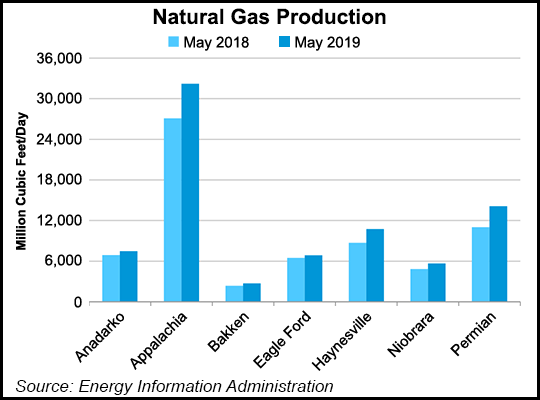Shale Daily | E&P | NGI All News Access | NGI The Weekly Gas Market Report
Natural Gas Production from U.S. Unconventional Plays to Near 80 Bcf/d in May, Says EIA
The United States’ seven most prolific onshore unconventional will churn out nearly 80 Bcf/d of natural gas in May, which is expected to be their 29th consecutive month-to-month increase, according to the U.S. Energy Information Administration (EIA).

Total production from the seven plays is expected to reach 79.84 Bcf/d next month, compared with an estimated 78.93 Bcf/d in April, according to EIA’s latest Drilling Productivity Report (DPR), which was released Monday.
Natural gas production increases are expected in six of the seven regions, with the Appalachian Basin forecast to produce 32.22 Bcf/d versus 31.86 in April, according to the DPR. EIA also expects increases in the Bakken (2.73 Bcf/d from 2.72 Bcf/d), Eagle Ford (6.88 Bcf/d from 6.85 Bcf/d), Haynesville (10.75 Bcf/d from 10.52 Bcf/d), Niobrara (5.65 Bcf/d from 5.58 Bcf/d) and Permian (14.12 Bcf/d from 13.89 Bcf/d). The Anadarko is expected to decline slightly to 7.49 Bcf/d in May from 7.51 Bcf/d in April.
At the same time, oil production is expected to increase in five of the seven regions to a total of 8.46 million b/d from an estimated 8.38 million b/d this month. EIA expects production in Appalachia next month to be 135,000 b/d (compared to 131,000 b/d this month), Bakken (1.39 million b/d from 1.37 million b/d), Eagle Ford (1.43 million b/d from 1.42 million b/d), Niobrara (764,000 b/d from 742,000 b/d), and Permian (4.14 million b/d from 4.09 million b/d). The Anadarko is expected to decline marginally month/month to 567,000 b/d, and the Haynesville (44,000 b/d) is forecast to see oil production remain unchanged month/month.
EIA has been reporting consecutive month-to-month increases out of the plays since January 2017, when their total gas production was estimated at 47.51 Bcf/d, and total oil production was an estimated 4.54 million b/d.
Drilled but uncompleted (DUC) well counts across the Big Seven ended March at 8,500, a decrease of 4 from February, EIA said.
The bulk of the DUCs remain in the Permian, which increased 49 in March to 4,021, and in the Eagle Ford, which declined by five to 1,540. Four Big Seven plays saw their DUC numbers decrease from February: the Anadarko (minus 29), Appalachia (minus 8), Bakken (minus 12) and Eagle Ford (minus five).
EIA overstates the large number of DUCs in the U.S. onshore and underlying data needs to be reviewed, according to a recent report from Raymond James & Associates Inc. EIA data “overstates the true amount of DUCs,” according to Raymond James analysts. “That is because the EIA includes thousands of ‘Forgotten UnCompleted wells’ that were drilled years ago and are never likely to be completed in the future.” The Raymond James team estimated that the EIA DUC data was overstated by almost 30%, or about 2,000 wells.
The productivity of new oil wells in the Big Seven plays is expected to increase in May to 692 b/d, according to the DPR. New-well gas production per rig is also expected to increase during the month to 3.93 MMcf/d.
EIA compiles the DPR using recent U.S. data on the total number of drilling rigs in operation along with estimates of drilling productivity and estimated changes in output from existing wells to provide estimated changes in production.
© 2024 Natural Gas Intelligence. All rights reserved.
ISSN © 2577-9877 | ISSN © 1532-1266 | ISSN © 2158-8023 |
